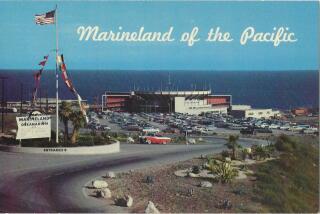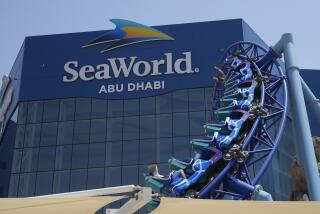Sea World President Fired in Aftermath of Whale Accident
- Share via
The president of Sea World was fired Tuesday in the wake of an accident during a killer whale performance that seriously injured a trainer.
Jan Schultz, 53, a 17-year employee of the aquatic park, was fired shortly after park owner Harcourt Brace Jovanovich announced that he and three other top Sea World executives had been suspended following the Nov. 21 accident.
Whether the three other employees--chief trainer David Butcher, zoological director Lanny Cornell and public relations chief Jackie Hill--lost their jobs as well could not be confirmed late Tuesday.
Trainer John Sillick, 26, was seriously injured Nov. 21 when a whale performing a “breach,” or arching, stunt flipped in the air and landed on Sillick as he rode astride another killer whale. Admitted to UC San Diego Medical Center with several injuries, including a broken pelvis, ribs and upper leg, Sillick was reported in fair condition there Tuesday.
Several Other Injuries
Sillick’s was the most recent of several injuries that trainers have suffered at the tourist attraction during rehearsals or performances in the last year.
“As president and chief executive officer, I ultimately have to accept responsibility for John Sillick’s injury,” Schultz said. “But by the same token, I think I’m a scapegoat.”
In an announcement Tuesday afternoon by Sea World, HBJ had said only that four employees were suspended but did not name them. The Orlando, Fla.-based company also said that it had decided to ban trainers from the pools during performances with the huge marine mammals. HBJ owns Sea World; similar parks in Orlando, Cleveland and San Antonio, and various publishing concerns.
The company’s announcement had said the employees would remain off the job with pay until new safety measures, some of which were announced by Sea World on Tuesday, are in place. The new measures include the installation of an underwater sonic communication system already used in Sea World’s Orlando park to elicit certain “behaviors,” or stunts, from the killer whales.
Trainers have not performed in the water with the whales for the last several days.
Officials at Sea World and HBJ had refused to comment on reports that had circulated for two days that top Sea World executives had been suspended until the Tuesday afternoon press release.
HBJ Executive Vice President Peter Jovanovich also declined to comment Tuesday.
Citing Sea World sources, TV station KCST (Channel 39) said Tuesday that there had been an increase in the number of accidents since two killer whales were brought to San Diego in January from now-defunct Marineland in Rancho Palos Verdes. The television station reported that three trainers had suffered previously undisclosed serious neck injuries.
Schultz acknowledged Tuesday night that Sea World has had “a series of accidents that are more serious than we’ve had in a short period before,” but he said the reasons are still unclear.
Schultz defended the safety of Sea World’s aquatic shows, arguing that the park had assembled “the greatest team possible” to assure the safety of the humans and performers.
“No one feels worse about the unfortunate accident than I do,” Schultz said.
HBJ bought Marineland in late 1986 for $23.4 million, principally to obtain the park’s killer whales because federal regulations forbid Sea World parks from capturing new whales, some critics have said. Marineland was closed one month after HBJ moved the whales to Sea World.
In its statement Tuesday, Sea World said it was taking the safety measures to “avoid the recurrence of the kind of accident that took place” Nov. 21. The measures were recommended by a four-member panel of HBJ executives who were asked to study “procedures involving trainers in their relations to animals.”
HBJ is “examining the role of park managers in ensuring the health and safety of its employees as well as animals,” the statement said. Until all new safety measures are in place, the suspended Sea World employees will remain off the job, the HBJ statement said.
The turmoil is developing as Sea World registers its best attendance year yet. Crowds in September, for example, were 40% above the September, 1986, level, according to the San Diego Convention & Visitors Bureau.
Sea World spent $18 million last year expanding its principal marine stadium to 3,500 seats and its total area to 110 acres from 95.
More to Read
Inside the business of entertainment
The Wide Shot brings you news, analysis and insights on everything from streaming wars to production — and what it all means for the future.
You may occasionally receive promotional content from the Los Angeles Times.










